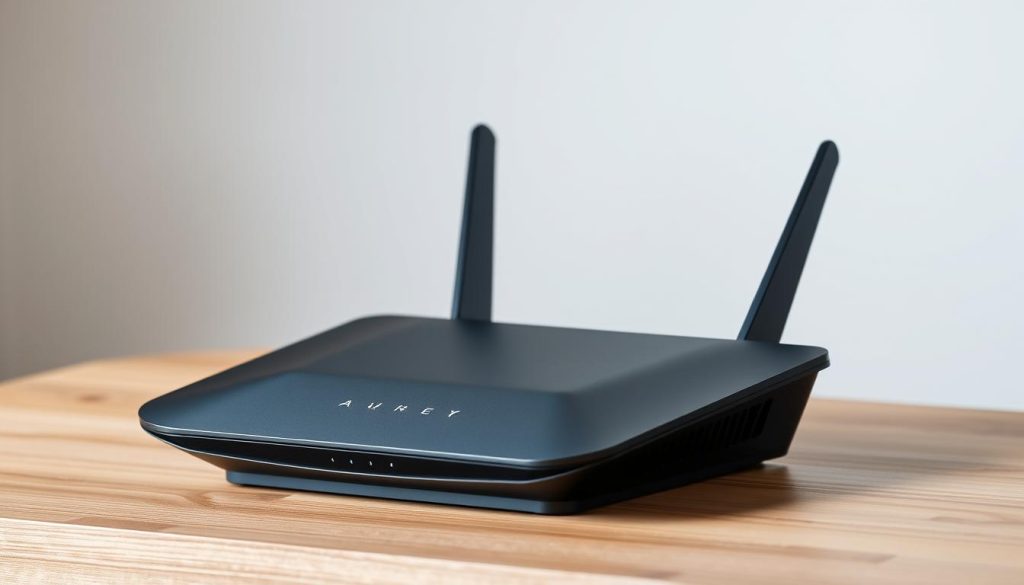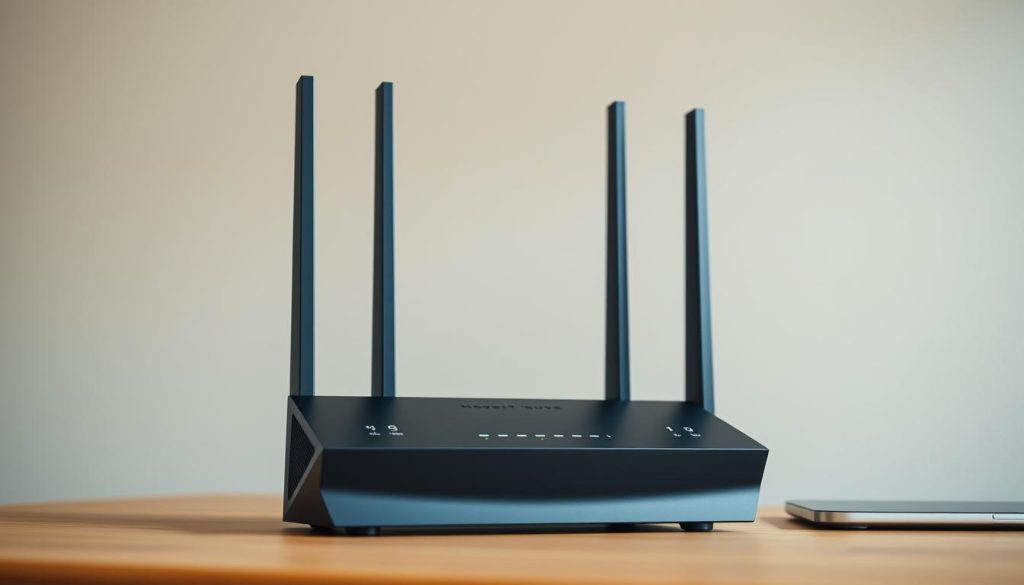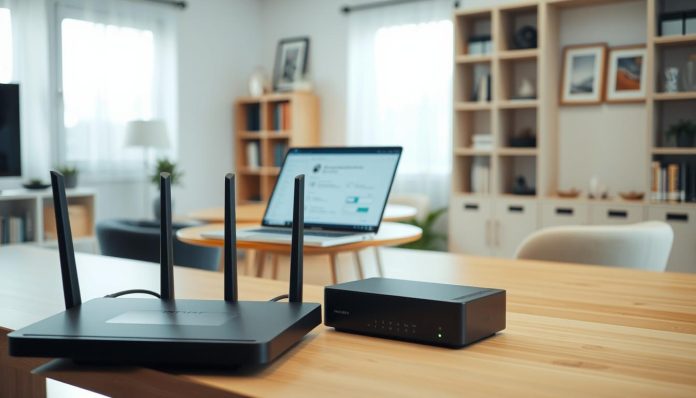Your home network is the backbone of school, work, streaming, and smart security. We set out the trade-offs in plain terms so a quick, smart decision replaces a default rental that may cost more over time.
Renting provider hardware often runs $10–$15 per month and can exceed purchase price in 12–24 months. Many all-in-one boxes include support and convenience, but they can be locked, outdated, or limited to 2–4 gigabit LAN ports — a hidden bottleneck for local performance.
Buying gives control: match a DOCSIS 3.1 cable modem to a capable router and unlock true gigabit speed, better coverage, and advanced features like granular parental controls and guest networks.
We’ll show when a single gateway is fine, where it falls short, and how to pick the right modem router setup for a safer, faster home. That’s where HPN makes the difference.
Modem vs. Router vs. Gateway: The simplest way to tell them apart
Picture three roles in any home internet setup: the translator, the traffic cop, and the combo tool.
The translator connects your house to the access line—coax for cable, a phone line for DSL, or an ONT for fiber. It usually has one input from the wall and one Ethernet out to a router.
The traffic cop creates WiFi, assigns IPs, and manages which devices get priority. Routers vary by bands—single, dual, tri—and modern units support WiFi 6/6E for better bandwidth and fewer conflicts.
The combo tool combines both roles in one box. A router combo saves space and setup time but can limit upgrades and advanced features.
Quick checks on a label help: look for WAN for the incoming Ethernet and LAN for wired devices. For cable users, seek DOCSIS 3.1 on a cable modem when shopping for gigabit speeds.

Pro tip: confirm compatibility with your provider before swapping equipment—checking approved equipment lists avoids slowdowns and service problems.
Do I need my own modem and router or is the ISP gateway enough?
Choosing between rented hardware and a personal kit shapes speed, costs, and control for every household.

Pros of renting: convenience, automatic updates, and quick replacements from your provider. For a small apartment with light use, a rented box that includes support may be the simplest option.
Pros of buying: better performance, advanced features, and long-term savings. A one-time upfront cost often pays back in 12–18 months compared with monthly rental fees.
Ask yourself three quick questions: Do you see dead spots or slowdowns during peak hours? Are advanced features like guest networks or parental controls important? Will you keep the same provider beyond a year? If you answered yes to any, retail gear likely helps.
Worried about support? Providers still handle the service line, and most retail equipment carries warranties plus active help communities. For cable and dsl, check approved equipment lists before buying—activation is a five‑minute check that avoids delays.
Bottom line: weigh rental fees against upfront cost and performance needs. For power users and busy families, buying equipment gives control and lasting speed. That’s where HPN makes the difference.
Renting your ISP’s equipment vs. buying your own: costs, performance, and support
Monthly hardware choices quietly shape annual bills and home network performance.
Renting means predictable rental fees—typically $10–$15/month—easy swaps, and one number to call for support. That’s convenient for short leases or low‑demand homes, but fees compound and hardware often trails current speeds.
Buying brings a higher upfront cost—buying modem averages ~$127 and routers vary widely—but pays back in 12–24 months for many families. Retail gear unlocks DOCSIS 3.1 for gigabit cable, stronger radios, and smarter QoS for sustained speeds.
Practical middle ground: keep a provider‑included cable modem when offered and add a retail router for better coverage. That avoids extra fees while improving performance for streaming, backups, and smart devices.
Support reality: providers still support the line; vendors support hardware. Lifespan is 3–5 years for most modems and routers—budget for replacements and watch for port limits on gateway boxes that can bottleneck local traffic.
If you want pro‑grade performance and real safety, we can configure, deploy, and manage it for you. That’s where HPN makes the difference.
The hidden costs ISPs don’t advertise: rentals, “WiFi” fees, and mesh upsells
Monthly line items from providers often hide extra services that quietly raise bills. Those “equipment” and “WiFi” lines can be separate—sometimes a modem is free while a router carries a persistent fee.
Providers pitch router combo simplicity, then add charges for “managed WiFi” or premium service. That creates recurring cost without meaningful speed gains.
Cheap extender bundles and entry-level mesh kits promise whole-home coverage but often daisy-chain weak signals. If the core device lacks modern radios, you extend a bottleneck—not fix it.
We’ve seen isps deploy older equipment with limited LAN ports and locked admin pages. Those limits block upgrades and make diagnosing network issues harder.
Quick checklist: audit monthly fees, compare long-term cost of renting mesh nodes, and avoid paid “security” that acts only as basic filtering.
For large or multi-story homes, buying a quality mesh paired with a proper modem saves money and boosts performance. That’s where HPN makes the difference.
When a single ISP gateway is fine—and when it holds you back
A single box can be fine for simple homes, but it often hides limits until traffic spikes. For a small apartment with fewer than ten devices on a modest plan, a rented router combo usually delivers steady internet speed and basic coverage.
Use this quick checklist to assess options: space size, number of devices, plan speed, and apps used. If you have multiple floors, many streaming TVs, cameras, or frequent video calls, a single unit will strain bandwidth and lower performance.
Technical notes: cable gigabit requires a DOCSIS 3.1 cable modem to reach advertised speeds. DSL and fiber lines bring their own constraints—better radios can’t fix a slow line. Bridge mode lets your retail router take over routing duties; DMZ helps when bridge isn’t available, while double NAT is a last-resort workaround.
If you reboot the box nightly or see consistent slowdowns at peak hours, routing duties should move to more capable equipment. For managed installs and secure setups that free up performance, that’s where HPN makes the difference.
Buying smart: modem and router tips for the best speed, coverage, and compatibility
We recommend buying modem gear with a plan—shop for equipment that matches speeds, layout, and provider rules.
Start with your provider’s approved list. Activation fails save no one time—checking compatibility takes minutes and prevents hassle.
For cable plans at or above 1 Gbps, pick DOCSIS 3.1. That standard keeps a cable modem future‑ready and avoids an early upgrade.
Prefer separate units: a dedicated modem plus a strong router gives better performance and cheaper upgrades later. Match router class to home size—WiFi 6/6E radios, a solid CPU, and security features matter.
Plan ports and coverage—look for a multi‑gig WAN/LAN port if you move large files. For DSL, confirm ADSL2+/VDSL2 needs and PPPoE details before purchase.
Keep firmware current; set a quarterly reminder. If you want a hands‑off, professionally hardened setup, we’ll spec, deploy, and secure it for you—order your HPN Defender install today.
Control and security: why a dedicated home firewall/router can be a better alternative
A single appliance can hand you internet, but it rarely gives deep visibility into threats on your network.
Gateways focus on getting you online; a security-first router prioritizes visibility, control, and resilience. With a dedicated firewall you can set per-device limits, isolate smart gear, and enforce family time rules without guessing which app uses bandwidth.
Professional platforms ship timely fixes and advanced features—firewall policies, QoS, parental controls, guest networks, always‑on VPNs, and IDS/IPS. That moves protection well beyond check‑box settings found in basic firmware.
We design HPN Defender to sit at the core of your home network—filtering threats, stabilizing performance, and giving straightforward dashboards that families actually use. Provider support still covers the line; we cover the stack and human help when policies need tuning.
Options scale with needs: pair a Defender with an approved modem, add mesh access points for coverage, or tune for DSL lines so calls and classes stay smooth. For real peace of mind, a dedicated firewall/router is the cleanest path—That’s where HPN makes the difference.
Real-world playbook: scenarios to decide rent vs. buy
Let’s map everyday setups to specific recommendations so action happens in minutes.
Small apartment, cable internet, short lease: keep a rented gateway if it’s included. If WiFi costs extra, keep the free modem and buy a good router to avoid recurring fees.
Suburban family with many devices: buy a DOCSIS-ready cable modem approved by your isp plus a WiFi 6 router or mesh. That combo gives stable speeds, broad coverage, and better parental controls.
Rural DSL with limited throughput: invest in a quality router for coverage and QoS but don’t overspend on ultra-fast radios—your connection is the bottleneck.
Work-from-home pro: own the modem and a business-class router, enable QoS and VPN fail-safes, and consider a dedicated firewall for policy-driven protection.
Quick tips: gamers should pick multi-gig LAN routers; budget homes should compare upfront cost vs. rental fees—breakeven often hits in 12–18 months. For cable activation, register the new device MAC via self-activation portals (Xfinity, Cox, Spectrum); use bridge mode when available or DMZ as a workaround. For security-minded families, a dedicated firewall like HPN Defender plus chosen access points brings pro-grade filtering—That’s where HPN makes the difference.
Conclusion
Treat your home network like a utility—simple upkeep pays back fast.
For most households, owning the right equipment delivers better speed, coverage, control, and security at a lower total cost. Buying gear often recoups its cost in 1–2 years. On cable plans, align with DOCSIS 3.1 for gigabit performance and check approved lists for smooth activation and compatibility.
Many isps include a free modem but charge for managed WiFi. Gateways are convenient yet limited in features and firmware cadence. If you want reliable performance and stronger security, step up to purpose-built routers or a dedicated firewall paired with an approved modem/ONT.
Verify compatibility, pick standards that match your plan, keep firmware current. Prefer professional installs for hands-off protection—That’s where HPN makes the difference. Order your HPN Defender install today.

